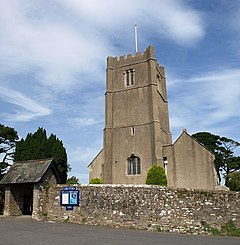Highweek
| Highweek | |
|---|---|
 All Saints Church, Highweek |
|
| Highweek shown within Devon | |
| OS grid reference | SX846720 |
| Civil parish |
|
| District | |
| Shire county | |
| Region | |
| Country | England |
| Sovereign state | United Kingdom |
| Post town | NEWTON ABBOT |
| Postcode district | TQ12 |
| Dialling code | 01626 |
| Police | Devon and Cornwall |
| Fire | Devon and Somerset |
| Ambulance | South Western |
| EU Parliament | South West England |
| UK Parliament | |
Highweek, less commonly called Highweek Village, is a former village, now administratively part of the market town of Newton Abbot in South Devon, England. It is prominent and recognisable due to its high location on a ridge on the north edge of the town. Highweek is also a church parish. The village is the centre of the electoral ward of Bradley. Its population at the 2011 census was 5,043.
The Normans built a motte-and-bailey castle here and it probably remained occupied until the mid 13th century. The church, now a Grade I listed building, was consecrated in 1428 after the villagers petitioned the pope for their own graveyard. Today, the village has been absorbed into Newton Abbot, but it retains its village identity.
The first documentary reference to the place now known as Highweek is as Teyngewike in c. 1200. This referred to its position as a settlement (wick from Anglo-Saxon wic) near the River Teign. By 1301 it was being called Heghwyk, the reference to the prominent (high) hill on which it stands having taken over though the name Teignweek was still in use as late as 1850.
Highweek stands in an area which experienced invasion and settlement in around 700 AD by the Saxons and then by the Danes in 1001 AD, when they sacked and pillaged the nearby village of Kingsteignton. In the village is a Norman motte-and-bailey earthwork known as Castle Dyke, that was built to protect the manor of Teignwick. It is a scheduled monument that is included in the "At Risk" register, but still stands tall "...crowned by two surviving pines."
The parts of the Hundred of Teignbridge—including Teignwick—that lay to the west of the River Teign were owned by the king, but in 1237 Henry III granted them to Sir Theobald de Englishville. De Englishville apparently never married and had no children, and shortly before his death in 1262 he conveyed his lands to his nephew Robert Bushel, who held them until his death in 1269. This was apparently an early death, for he left as his heir a son, named Theobald, aged only four years. Theobald's guardians were Henry and Matilda de Bickleigh and it is likely that they abandoned Castle Dyke in favour of a new manor house built in the nearby valley of the River Lemon around this time.
...
Wikipedia

